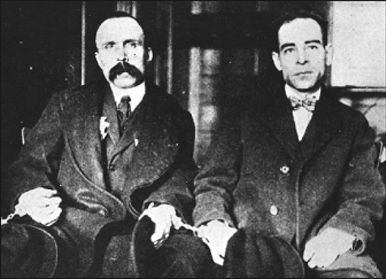By Jerry Tallmer
Imagine a 19-year-old kid in the snows of New Hampshire holding a new book of American poetry in his hand and shuddering with emotion when he first comes across the several dozen lines that start: “If it had not been for these things, I might have lived out my life talking at street corners to scorning men. I might have died unmarked, unknown, a failure. Now we are not a failure. This is our career and our triumph … That last moment belongs to us. That agony is our triumph.”
The words had been spoken — perhaps in court, perhaps in a death-row jail cell to an enterprising newspaperman, perhaps both — by Bartolomeo Vanzetti, headed for the chair in Brocton, Massachusetts, along with fellow anarchist Nicola Sacco, in August of 1927, a mere dozen years before our Dartmouth College sophomore stumbled on those lines in that new anthology of American poetry.
You will also come across a few of those words toward the end of “Sacco and Vanzetti,” the clear, cool 81-minute documentary by Peter Miller that opens March 30 at the Quad Cinema, though one longs for the full, emotive final statement by Vanzetti that ends with this paean to his “good shoemaker” co-defendant: “Sacco’s name will live in the hearts of the people and in their gratitude when Katzman’s [the prosecutor’s] and your [Judge Thayer’s] bones will be dispersed by time; when your name, his name, your laws, institutions, and your false god are but a dim remembering of a cursed past in which man was wolf to the man.”
Webster Thayer — a Dartmouth man, be it noted. The trial, for the (hotly disputed to this day) murders of a South Braintree factory paymaster and his payroll guard, lasted seven weeks; the jury came in with a verdict in two hours. When the distinguished Prof. James Richardson ran into Webster Thayer on the street, he enquired: “Did you do away with those anarchist bastards?” The professor might or might not have in fact said “those wop, dago, guinea bastards,” words that came easily to that goodly share of America that feared and detested immigrants then as now — an America that in those days, as we learn from this documentary, could set 500 such immigrants, many of them from Italy, chained together, walking toward jail through the streets of Boston.
It has now been 80 years since the execution of Sacco and Vanzetti tore the United States half apart — and caused a great deal more hullabaloo elsewhere around the globe — in mass demonstrations of hurt, outrage, and fury, bucking against the flanks and flailing clubs of the mounted police, a/k/a Cossacks.
Of course the Communists in this country and elsewhere immediately seized on Sacco & Vanzetti as agitprop — of course they did. “They’re better off dead,” was the Party line. “What good are they to us alive?”
But if the Communists jumped on the case, so did a great many other people who were not Communists at all, or very offbeat sorts of Communists — writers and artists and actors and singers and poets from Upton Sinclair to Dorothy Parker to Diego Rivera to Edna St. Vincent Millay to Woody Guthrie to hundreds of others, and none more effectively than the Ben Shahn whose woodcut Sacco and Vanzetti poster is sort of the cornerstone of Peter Miller’s film.
Of its very nature, the footage between the archival footage is a panoply of talking (or music-making) heads, from Howard Zinn to Studs Terkel to Anton Coppola to Arlo Guthrie — and many others — to Jeanette Murphy, daughter of the slain paymaster. “Do I think they killed my father?” she says on camera. “Well, somebody did.”
Tell you what. That 19-year-old kid from New York, the sophomore up there in the snows of New Hampshire with the anthology of poetry in his hand, had already seen and been deeply affected by a film metaphorically stemming from the Sacco and Vanzetti case, with Burgess Meredith as a young wanderer named “Mio Romagna,” come to the waterfront in search of the justice that had been denied his father, and falling in love with the beautiful Margo. There is even a Judge Thayer in it, in the form of a “Judge Gaunt” (Edward Ellis), haunted by the deaths he’d imposed, and a gangster (the real murder boss) unforgettably played by Eduardo Cianelli. That movie is “Winterset,” adapted from the play by Maxwell Anderson — the father, as it happens, of a high-school classmate of the kid who went to Dartmouth.
The kid never forgot “Winterset,” and never will. It would make a nice counterpoise, adding some juice and emotional heft to the good workmanlike movie that’s about to open at the Quad.
SACCO AND VANZETTI. Directed by Peter Miller. A First Run Features release produced by him and Amy Carey Linton. 81 minutes. Opens March 30 at the Quad Cinema, 34 W 13th St., 212-255-8800


































